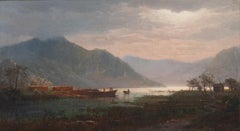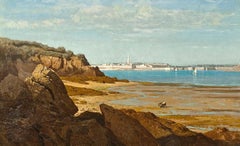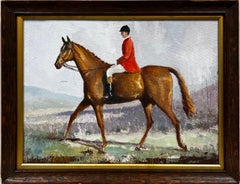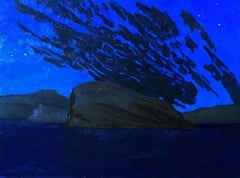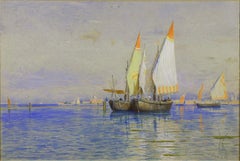William Stanley Haseltine Art
to
2
2
1
Morning on the River
By William Stanley Haseltine
Located in New York, NY
William Stanley Haseltine paints a rowboat on a river running between mountain peaks and beneath dramatic rosy clouds in his oil painting “Morning on the River.”
Category
Late 19th Century William Stanley Haseltine Art
Materials
Canvas, Oil
Saint-Malo, Brittany
By William Stanley Haseltine
Located in New York, NY
The career of William Stanley Haseltine spans the entire second half of the nineteenth century. During these years he witnessed the growth and decline of American landscape painting, the new concept of plein-air painting practiced by the Barbizon artists, and the revolutionary techniques of the French Impressionists, all of which had profound effects on the development of painting in the western world. Haseltine remained open to these new developments, selecting aspects of each and assimilating them into his work. What remained constant was his love of nature and his skill at rendering exactly what he saw. His views, at once precise and poetic, are, in effect, portraits of the many places he visited and the landscapes he loved.
Haseltine was born in Philadelphia, the son of a prosperous businessman. In 1850, at the age of fifteen, he began his art studies with Paul Weber, a German artist who had settled in Philadelphia two years earlier. From Weber, Haseltine learned about Romanticism and the meticulous draftsmanship that characterized the German School. At the same time, Haseltine enrolled at the University of Pennsylvania, and took sketching trips around the Pennsylvania countryside, exploring areas along the Delaware and Susquehanna rivers. Following his sophomore year, Haseltine transferred to Harvard University.
After graduating from Harvard in 1854, Haseltine returned to Philadelphia and resumed his studies with Weber. Although Weber encouraged Haseltine to continue his training in Europe, the elder Haseltine was reluctant to encourage his son to pursue a career as an artist. During the next year, Haseltine took various sketching trips along the Hudson River and produced a number of pictures, some of which were exhibited at the Pennsylvania Academy of the Fine Arts in the spring of 1855. Ultimately, having convinced his father that he should be allowed to study in Europe, Haseltine accompanied Weber to Düsseldorf.
The Düsseldorf Academy was, during the 1850s, at the peak of its popularity among American artists. The Academy’s strict course of study emphasized the importance of accurate draftsmanship and a strong sense of professionalism. Landscape painting was the dominant department at the Düsseldorf Academy during this period, and the most famous landscape painter there was Andreas Achenbach, under whom Haseltine studied. Achenbach’s realistic style stressed close observation of form and detail, and reinforced much of what Haseltine had already learned. His Düsseldorf training remained an important influence on him for the rest of his life.
At Düsseldorf, Haseltine became friendly with other American artists studying there, especially Emanuel Leutze, Worthington Whittredge, and Albert Bierstadt. They were constant companions, and in the spring and summer months took sketching trips together. In the summer of 1856 the group took a tour of the Rhine, Ahr, and Nahe valleys, continuing through the Swiss alps and over the Saint Gotthard Pass into northern Italy. The following summer Haseltine, Whittredge, and the painter John Irving returned to Switzerland and Italy, and this time continued on to Rome.
Rome was a fertile ground for artists at mid-century. When Haseltine arrived in the fall of 1857, the American sculptors Harriet Hosmer, Chauncey B. Ives, Joseph Mozier, William Henry Rinehart...
Category
19th Century American Realist William Stanley Haseltine Art
Materials
Canvas, Oil
Related Items
Classic British Sporting Art Oil Painting Huntsman on Horseback Winter Landscape
Located in Cirencester, Gloucestershire
Artist/ School: British School, 20th century
Title: Huntsman on horseback, wintery landscape behind.
Medium: oil painting on canvas, oak wooden framed
Framed: 14 x 17.5 inches
C...
Category
Mid-20th Century Victorian William Stanley Haseltine Art
Materials
Canvas, Oil
Norway III, dark blues and blacks, night sky
By Gregory Frux
Located in Brooklyn, NY
Dr. Rowland S. Russell PhD. writes about his experience directly witnessing Greg's practice as a “plein air” artist:
Whether he’s portraying quiet scenes from Brooklyn’s Prospect Park or the Botanical Gardens, intriguing remnants of New York’s varied industry (grain silos...
Category
2010s American Realist William Stanley Haseltine Art
Materials
Oil, Canvas
FRENCH POST-IMPRESSIONIST SIGNED OIL - HILL TOP PERCHED VILLAGE PROVENCE
By Gerard Laime
Located in Cirencester, Gloucestershire
Artist/ School: Gerard Laime (French b. 1939), signed
Title: The Hill Top Perched Village, Provence
Medium: oil painting, on canvas.
Size: frame...
Category
20th Century Post-Impressionist William Stanley Haseltine Art
Materials
Canvas, Oil
1950's French Post Impressionist Oil Figures in Provencal Village Landscape
Located in Cirencester, Gloucestershire
Artist/ School: French Post Impressionist School, circa 1950's
Title: Figures in a sloped Provencal village landscape
Medium: oil painting on canvas, unframed
canvas: 23.75 x 28.7...
Category
Mid-20th Century Impressionist William Stanley Haseltine Art
Materials
Oil, Canvas
20th Century French Cubist Oil Painting Street View at Night Time
Located in Cirencester, Gloucestershire
Artist/ School: French 20th Century artist
Title: Cubist street scene at dusk
Medium: oil painting on canvas, unframed.
canvas: 25.5 x 21.25 inches
Provenance: private collectio...
Category
20th Century Cubist William Stanley Haseltine Art
Materials
Oil, Canvas
Antique Irish Oil Painting Mountain Lake Scene Soft Golden Colors & Hills
Located in Cirencester, Gloucestershire
Artist/ School: Irish School, early 20th century, indistinctly signed lower corner
Title: Golden Sunlight over the soft mountains of Ireland.
Medium: ...
Category
Early 20th Century Victorian William Stanley Haseltine Art
Materials
Oil, Canvas
Superb French Impressionist Signed Oil Old Provencal Village, Stunning Frame
Located in Cirencester, Gloucestershire
Artist/ School: French Impressionist School, 20th century, indistinctly signed
Title: Provencal country landscape
Medium: signed oil painting on canvas, framed
Size:
framed: 2...
Category
20th Century Impressionist William Stanley Haseltine Art
Materials
Canvas, Oil
Automne d'or by André Brasilier
By André Brasilier
Located in New Orleans, LA
André Brasilier
French I b. 1929
Automne d'or
Signed “André Brasilier” (lower right)
Oil on canvas
In Automne d'or, celebrated French artist André Brasilier exquisitely conveys th...
Category
20th Century Modern William Stanley Haseltine Art
Materials
Canvas, Oil
Stock Pond in the Summer, Landscape Oil , Realism, Texas Hill Country
By Garrett Middaugh
Located in Houston, TX
Stock Pond in the Summer depicts the Texas Hill Country which is Garrett Middaugh's favorite painting locations. This is painted in the style of Reali...
Category
2010s American Realist William Stanley Haseltine Art
Materials
Cotton Canvas, Oil
Very Large 20th Century French Expressionist Abstract Oil Painting on Canvas
Located in Cirencester, Gloucestershire
Artist/ School: French Expressionist painter, circa 1970
Title: abstract expressionist composition
Medium: oil painting on canvas, unframed
canvas: 39.25 x 25.5 inches
Provenance...
Category
20th Century Abstract Expressionist William Stanley Haseltine Art
Materials
Oil, Canvas
Untitled
Located in Los Angeles, CA
Large, oil on canvas by German artist Paul von Ravenstein (1854-1938). Signed lower left corner. Framed in a hand-carved, gilt-wood frame. Ravenstein studied the changes in color c...
Category
Late 19th Century William Stanley Haseltine Art
Materials
Canvas, Oil
"Motion, " Victor Arnautoff, San Francisco Lighthouse, World's Fair WPA Painting
By Victor Michail Arnautoff
Located in New York, NY
Victor Mikhail Arnautoff (1896 - 1979)
Motion (Mile Rocks Lighthouse), San Francisco, 1939
Oil and tempera on board
60 x 40 inches
Signed lower left
Provenance:
The artist
California School of Fine Arts (CFSA)
John & Lynne Bolen Fine Arts, Huntington Beach, California
Exhibited:
New York, World's Fair, Exhibition of Contemporary American Art, 1939.
San Francisco Museum of Art, 1962.
Literature:
American Art from the New York World's Fair 1939, Poughkeepsie, 1987, no. 11, p. 41, illustrated.
Robert W. Cherny, Victor Arnautoff and the Politics of Art, Urbana, Illinois, 2017.
The lighthouse in the distance is the Mile Rocks Lighthouse in San Francisco Bay, built in 1906 after many shipwrecks made the lighthouse necessary. In 1962 the lighthouse was reduced in size to make room for a helipad.
Arnautoff was the son of a Russian Orthodox priest. He showed a talent for art from an early age and hoped to study art after graduating from the gymnasium in Mariupol. With the outbreak of World War I, he enrolled in the Yelizavetgrad Cavalry School. He went on to hold military leadership positions in the army of Nicholas II and the White Siberian army. With the defeat of the Whites in Siberia, he crossed into northeastern China and surrendered his weapons. Arnautoff remained in China for five years. He again tried to pursue art, but was impoverished and took a position training the cavalry of the warlord Zhang Zuolin. He met and married Lydia Blonsky and they had two sons, Michael and Vasily.
In November 1925 Arnautoff went to San Francisco on a student visa to study at the California School of Fine Arts. There he studied sculpture with Edgar Walter and painting with several instructors. His wife and children joined him, and they all continued to Mexico in 1929, where, on Ralph Stackpole...
Category
1930s American Realist William Stanley Haseltine Art
Materials
Tempera, Oil, Canvas
Previously Available Items
Fishing Boats, Venice
By William Stanley Haseltine
Located in New York, NY
Fishing Boats, Venice recalls a time, a place, and a social circle that lived for a charmed moment and a favored few in nineteenth-century Europe. William Stanley Haseltine was an American expatriate artist who made his home and studio “into a permanent meeting ground for the many distinguished foreigners, Americans and English, who came to Rome. . . .” (Helen Haseltine Plowden, William Stanley Haseltine, Sea and Landscape Painter (1835-1900): Notes and Recollections From His Life [1947], p. 97). Among these were Louisa Crawford Ward (daughter of New York banker and art patron Samuel Ward, sister of Julia Ward Howe, and widow of American sculptor Thomas Crawford); Henry Wadsworth Longfellow; Frederick Crowninshield (Boston Brahmin poet and painter); artist Edward Darley Boit; lawyer Joseph Choate; historian George Bancroft; writer Charles Francis Adams; and financier Junius Spencer Morgan, father of John Pierrepont Morgan, the original owner of this work. From 1874 until the artist's death, the family lived in the Palazzo Altieri, a sixteenth-century residence built by Cardinal Gian Battista Altieri Seniore and his uncle Pope Clement X. The Haseltines gathered together under their splendid and commodious roof an international literary, cultural, and artistic salon with a distinctly American accent.
The career of William Stanley Haseltine spans the entire second half of the nineteenth century. During these years he witnessed the growth and decline of American landscape painting, the new concept of plein-air painting practiced by the Barbizon artists, and the revolutionary techniques of the French Impressionists, all of which had profound effects on the development of painting in the western world. Haseltine remained open to these new developments, selecting aspects of each and assimilating them into his work. What remained constant was his love of nature and his skill at rendering exactly what he saw. His views, at once precise and poetic, are, in effect, portraits of the many places he visited and the landscapes he loved.
Haseltine was born in Philadelphia, the son of a prosperous businessman. In 1850, at the age of fifteen, he began studying with Paul Weber, a German artist who had settled in Philadelphia two years earlier. From Weber, Haseltine learned about Romanticism and the meticulous draftsmanship that characterized the German School. At the same time, Haseltine enrolled at the University of Pennsylvania, and took sketching trips around the Pennsylvania countryside, exploring areas along the Delaware and Susquehanna rivers. Following his sophomore year, Haseltine transferred to Harvard University.
After graduating from Harvard in 1854, Haseltine returned to Philadelphia and resumed his studies with Weber. Although Weber encouraged Haseltine to continue his training in Europe, the elder Haseltine was reluctant to encourage his son to pursue a career as an artist. During the next year, Haseltine took various sketching trips along the Hudson River and produced a number of pictures, some of which were exhibited at the Pennsylvania Academy of the Fine Arts in the spring of 1855. Ultimately, having convinced his father that he should be allowed to study in Europe, Haseltine accompanied Weber to Düsseldorf.
The Düsseldorf Academy was, during the 1850s, at the peak of its popularity among American artists. The Academy’s strict course of study emphasized the importance of accurate draftsmanship and a strong sense of professionalism. Landscape painting was the dominant department at the Düsseldorf Academy during this period, and the most famous landscape painter there was Andreas Achenbach, under whom Haseltine studied. Achenbach’s realistic style stressed close observation of form and detail, and reinforced much of what Haseltine had already learned. His Düsseldorf training remained an important influence on him for the rest of his life.
At Düsseldorf, Haseltine became friendly with other American artists studying there, especially Emanuel Leutze, Worthington Whittredge, and Albert Bierstadt. They were constant companions, and in the spring and summer months took sketching trips together. In the summer of 1856 the group took a tour of the Rhine, Ahr, and Nahe valleys, continuing through the Swiss alps and over the Saint Gotthard Pass into northern Italy. The following summer Haseltine, Whittredge, and the painter John Irving returned to Switzerland and Italy, and this time continued on to Rome.
Rome was a fertile ground for artists at mid-century. Virtually every major artist went there at some point, and some set up permanent homes and studios. When Haseltine arrived in the fall of 1857, the American sculptors Harriet Hosmer, Chauncey B. Ives, Joseph Mozier, William Henry Rinehart...
Category
Late 19th Century American Realist William Stanley Haseltine Art
Materials
Watercolor
William Stanley Haseltine art for sale on 1stDibs.
Find a wide variety of authentic William Stanley Haseltine art available for sale on 1stDibs. You can also browse by medium to find art by William Stanley Haseltine in canvas, fabric, oil paint and more. Not every interior allows for large William Stanley Haseltine art, so small editions measuring 23 inches across are available. Customers who are interested in this artist might also find the work of James Edward Buttersworth, William Rickarby Miller, and Peter Poskas. William Stanley Haseltine art prices can differ depending upon medium, time period and other attributes. On 1stDibs, the price for these items starts at $110,000 and tops out at $110,000, while the average work can sell for $110,000.
